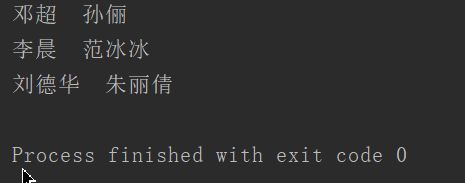Java——Map集合
目录
1、Map集合
1.1、 Map与Collection集合的区别
1.2、Map集合下的子类
2、HashMap集合
2.1、HashMap集合的特点
2.2、常用方法
2.3、什么是Entry?
2.4、Map集合的遍历
2.5、Map存储自定义类型元素
3、LinkedHashMap集合
3.1、LinkedHashMap的特点
3.2、代码演示
4、TreeMap集合
4.1、TreeMap集合特点
4.2、代码演示
5、经典面试题
5.1、Hashtable和HashMap的区别?
5.2、List,Set,Map等接口是否都继承子Map接口?
1、Map集合
现实生活中,我们常会看到这样的一种集合:IP地址与主机名,身份证号与个人,系统用户名与系统用户对象等,这种一一对应的关系,就叫做映射。Java提供了专门的集合类用来存放这种对象关系的对象,即
java.util.Map接口。
1.1、 Map与Collection集合的区别
Collection集合:单列集合,一次只能添加一个元素。子类有的有索引(ArrayList、Vector),有的没索引(LinkedList、Set)。有的集合可以储存重复元素(List),有的不可以(Set),有的是无序的(List、Set),有的是有序的(TreeSet)。
Map集合:双列集合,由key和value组成。key是不能重复,而value可以重复。key允许存储null,但是只能存储唯一的一个(Hashtable除外)。
1.2、Map集合下的子类
Map集合下的子类最常用的有三个,分别是HashMap、LinkedHashMap、TreeMap。
2、HashMap集合
2.1、HashMap集合的特点
无序,key唯一,允许key和value为null。
底层数据结构:数组+链表+红黑树
总结:key无序且唯一。
2.2、常用方法
| 方法名 | 说明 |
|---|---|
| public V put(K key, V value) | 把指定的键与指定的值添加到Map集合中。 |
| public V remove(Object key) | 把指定的键 所对应的键值对元素 在Map集合中删除,返回被删除元素的值。 |
| public V get(Object key) | 根据指定的键,在Map集合中获取对应的值。 |
| boolean containsKey(Object key) | 判断集合中是否包含指定的键。 |
| public Set |
获取Map集合中所有的键,存储到Set集合中。 |
| public Set |
获取到Map集合中所有的键值对对象的集合(Set集合)。 |
public class MapDemo {
public static void main(String[] args) {
Map map=new HashMap<>();
//添加key-value键值对
map.put("小明","李华");
map.put("小明","小青");
map.put("赵明","宋轶");
map.put("蕾蕾","紫紫");
System.out.println(map);
//删除指定key值的键值对,并返回对应的value值
String name1 = map.remove("小明");
System.out.println(name1);
System.out.println(map);
//获取指定key值的value
String name2 = map.get("赵明");
System.out.println(name2);
//判断map集合里是否具有蕾蕾这个key值
boolean flag = map.containsKey("蕾蕾");
System.out.println(flag);
//判断map集合中是否具有宋轶这个value值
boolean flag1 = map.containsValue("宋轶");
System.out.println(flag1);
//keySet方法返回一个Set集合 里面是所有的key值
Set set = map.keySet();
System.out.println(set);
//通过entrySet方法获取一个Set集合,里面是Map集合
Set> entries = map.entrySet();
System.out.println(entries);
}
} 2.3、什么是Entry?
Map中存放的是两种对象,一种称为key(键),一种称为value(值),它们在在
Map中是一一对应关系,这一对对象又称做Map中的一个Entry(项)。Entry将键值对的对应关系封装成了对象。即键值对对象,这样我们在遍历Map集合时,就可以从每一个键值对(Entry)对象中获取对应的键与对应的值。
public Set> entrySet(): 获取到Map集合中所有的键值对对象的集合(Set集合)。 | 方法名 | 说明 |
|---|---|
| public K getKey() | 获取Entry对象中的键。 |
| public V getValue() | 获取Entry对象中的值。 |
2.4、Map集合的遍历
public class MapDemo2 {
public static void main(String[] args) {
Map map=new HashMap<>();
//添加key-value键值对
map.put("小明","李华");
map.put("小明","小青");
map.put("赵明","宋轶");
map.put("蕾蕾","紫紫");
System.out.println(map);
//第一种遍历格式 使用keySet方法并通过map的get获取值
Set set = map.keySet();
for (String key : set) {
String value = map.get(key);
System.out.println(key+":"+value);
}
System.out.println("---------------------");
//第二种遍历格式 使用迭代器
Set set1 = map.keySet();
Iterator it = set1.iterator();
while(it.hasNext()){
String key = it.next();
String value = map.get(key);
System.out.println(key+":"+value);
}
System.out.println("----------------------");
//第三种遍历格式 使用entrySet方法 通过getKey和getValue方法获取
Set> entries = map.entrySet();
Iterator> it1 = entries.iterator();
while(it1.hasNext()){
Map.Entry map1 = it1.next();
String key = map1.getKey();
String value = map1.getValue();
System.out.println(key+":"+value);
}
System.out.println("----------------------");
//第四种遍历格式 jdk8新特性 lambda表达式
map.forEach((key,value)->{
System.out.println(key+":"+value);
});
}
}
2.5、Map存储自定义类型元素
1、当给HashMap中存放自定义对象时,如果自定义对象作为key存在,这时要保证对象唯一,必须复写对象的hashCode和equals方法(如果忘记,请回顾HashSet存放自定义对象)。
2、如果要保证map中存放的key和取出的顺序一致,可以使用
java.util.LinkedHashMap集合来存放。
学生类
public class Student {
private String name;
private int age;
public Student() {
}
public Student(String name, int age) {
this.name = name;
this.age = age;
}
public String getName() {
return name;
}
public void setName(String name) {
this.name = name;
}
public int getAge() {
return age;
}
public void setAge(int age) {
this.age = age;
}
@Override
public boolean equals(Object o) {
if (this == o)
return true;
if (o == null || getClass() != o.getClass())
return false;
Student student = (Student) o;
return age == student.age && Objects.equals(name, student.name);
}
@Override
public int hashCode() {
return Objects.hash(name, age);
}
}测试类
public class HashMapTest {
public static void main(String[] args) {
//1,创建Hashmap集合对象。
Mapmap = new HashMap();
//2,添加元素。
map.put(new Student("lisi",28), "上海");
map.put(new Student("wangwu",22), "北京");
map.put(new Student("zhaoliu",24), "成都");
map.put(new Student("zhouqi",25), "广州");
map.put(new Student("wangwu",22), "南京");
//3,取出元素。键找值方式
SetkeySet = map.keySet();
for(Student key: keySet){
String value = map.get(key);
System.out.println(key.toString()+"....."+value);
}
}
} 3、LinkedHashMap集合
3.1、LinkedHashMap的特点
有序,而且key不允许重复。
底层数据结构:哈希表(数组+链表+红黑树)
总结:有序,唯一
3.2、代码演示
public class LinkedHashMapDemo {
public static void main(String[] args) {
LinkedHashMap map = new LinkedHashMap();
map.put("邓超", "孙俪");
map.put("李晨", "范冰冰");
map.put("刘德华", "朱丽倩");
Set> entrySet = map.entrySet();
for (Entry entry : entrySet) {
System.out.println(entry.getKey() + " " + entry.getValue());
}
}
} 4、TreeMap集合
4.1、TreeMap集合特点
TreeMap集合键是红黑树结构,可以保证键的唯一和排序。
总结:key排序,唯一。
4.2、代码演示
public static void main(String[] args) {
// 创建集合对象 会对key进行排序,并且唯一
TreeMap tm = new TreeMap();
// 创建元素并添加元素
tm.put("a", "你好");
tm.put("c", "世界");
tm.put("e", "爪哇");
tm.put("b", "世界2");
tm.put("e", "爪哇EE");
// 遍历集合
Set set = tm.keySet();
for (String key : set) {
String value = tm.get(key);
System.out.println(key + "---" + value);
}
} 5、经典面试题
5.1、Hashtable和HashMap的区别?
HashMap:线程不安全,效率高,key和value可以为null。
HashTable:线程安全,效率低,key和value都不能为null。
5.2、List,Set,Map等接口是否都继承子Map接口?
List、Set不是继承自Map接口,它们继承自Collection接口,Map本身就是一个顶层接口,与Collection接口同一级。
